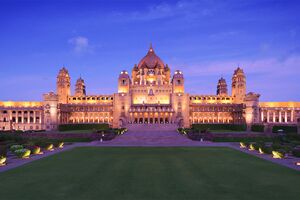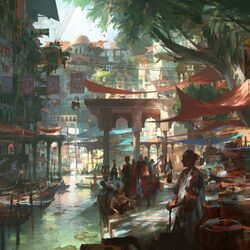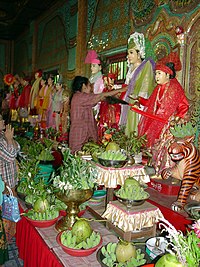Min
This article is incomplete because it is pending further input from participants, or it is a work-in-progress by one author. Please comment on this article's talk page to share your input, comments and questions. Note: To contribute to this article, you may need to seek help from the author(s) of this page. |
Realms of the Most Radiant Throne අදාත් සිංහාසනයේ ඊශ්වරානියා Adāt Siṁhāsanayē Īśvarāniyā | |
|---|---|
| Motto: විශ්වාසය හා දයාව Viśvāsaya hā Dayāva “Faith and Mercy" | |
| Anthem: හිරු-සිංහයාගේ දරුවන් Hiru-siṁhayāgē Daruvan (Pala) "People of the Sun-Lion" | |
| Location of Min in Borea Location of Min in Borea | |
| Capital | Surakuta |
| Largest City | Kini Maligawa |
| Official languages | Pala, Pavitri |
| Recognised national languages | Darwani |
| Ethnic groups | see Ethnology |
| Religion | Aditism |
| Demonym(s) | Min |
| Government | Devolved theocratic absolute monarchy |
• Empress | Cintamani |
| Guruvansha Sishya Samaya Sishya Tirabawaya | |
| Legislature | Śuddhasammūtiya |
| Holy Council of Jurists | |
| Celestial Court | |
| Foundation of Surapuluvi | |
| 700-800 BCE | |
• Spread of Aditism (First Radiance) | 23 BCE |
| 77 CE | |
| 183X | |
| 1901 | |
| Population | |
• 2018 census | 240,332,012 |
• Density | 148.68/km2 (385.1/sq mi) |
| GDP (nominal) | estimate |
• Total | 931 billion |
• Per capita | $17,143 |
| Gini | 31.55 medium |
| HDI (2013) | 0.773 high |
| Currency | Bulawan (பு) (MBL) |
| Driving side | left |
| Calling code | .461 |
| ISO 3166 code | MIN |
| Internet TLD | .mn |
| |
Min (මින්), officially known as the Realms of the Most Radiant Throne (Pala: අදාත් සිංහාසනයේ ඊශ්වරානියා Adāt Siṁhāsanayē Īśvarāniyā) is a sovereign state in southeastern Oraia in Oxar, bordered by Cadasia, Taghavan and Kadaria. It has a population of 240,332,012 people with about a third of them residing in the rural regions. Its capital, Surakuta is situated in its central coasts. The largest city is Kini Maligawa, bordering south of the capital.
A theocracy under the Heliolatric Order of the Mandala of Fire order, the Most Radiant Throne has long been a center of the religion since the foundation of the Holy Wheel (Shuddhamindala) in the onset of the first century BCE. Its capital Arukara is home to the Most Enlightened Sanctuary of the Flame of Heaven, the second holiest temple in Oraia, next to the Temple of Arutan in Taghavan. Holding formal protection of Taghavan and the Temple of Arutan, Min is considered the most potent claimant to the inheritance to the legacy of the ancient Salakura Empire.
The Min state itself was a merging of the institutions of the Temple and its immediate predecessor, the Queendom of Surapuluwi. The Most Radiant Throne itself was proclaimed in a coup by the high priestess of the Order, Haliyari in 77 CE. Haliyari, whose conquests of the Bay of Lions region would form the territorial nucleus of the early empire. Min hegemony would wax and wane over time with the rise of contesting thrones such as in Cadasia and Kadaria by the XXth century ("Age of Three Thrones"), rendering divine imperium back to Alash in Taghavan.
Things would come to ahead in XXXX when a cabal of Correctivist jurists, generals and nobles, led by Warden and Hierophant Tiru Nimar took over the government and put the imperial throne under arrest, establishing the Imperial Board for Glorious Reconstitution. This authoritarian regency would only be concluded in the assassination of the Nimar by succeeding Empress Dharanika, which immediately reinstituted the throne as the paramount authority in the empire, reversing almost every move by the Reconstitution Board. Since then, succeeding empresses have worked towards regaining the Throne's lost greatness through diplomatic and economic means.
Min today is a key power in Oxar, prevailing through the chaos of the XXX century. It has projected its power in Ecnia with the formalization of state authority in Mikinak and securing a presence in western Hakan. Min has also been noted for its rising cultural industry, which rival powers have asserted as a "projection of soft power". However, the relative youth of its current empress, Cintamani has rendered the state under the regency of the Archjurists. The archjurists, which already exists as an exclusive and secretive body, gives light to new fears of Correctivist rule.
Etymology
semitic loan?
Geography

Climate
Min sports a generally subtropical and temperate climate, though the interior, due to its mountainous terrain, sports a more latter climate. In the winter, the northern half of the Tenian plateau is generally alpine above the tree line a third of the year. The Taleju archipelago protects the region from the yearly monsoons and typhoons blowing west. The northern regions sport a three season (spring, summer, autumn) year while the lowland south only has two (summer, rainy).
Min's biomes are generally heavily forested, save for the coastal lowlands which support more traditional agriculture (see agriculture) though it tends to have variations between the north and south. The north, most particularly its mountainous highland regions, have a more temperate rainforest biome. The south has a more tropical biome, which is more pronounced during the summer. The average summer temperature in Min is 26°C while the winter averages to 3-5°C. Rainfall tends to be moderate to low, though it is much higher within the coastal and southern parts.
Biodiversity

History
Prehistory
- Indo-Rasheem region, some Khoisan interaction, dynamic later altered with the Sepcan-Monic migrations
Rise of the Old Kingdoms

Rise of Hirudewa and Sibari's Empire
From Taghavan comes a warrior who cleanses this land by fire. The god Aditi comes in the form of Hirudewa.
Blossom Period

Min gets so fuckin rich my dude
Avakang period
Fall of the empire and division
Correction of the prophecy
- reestablishment of Min dominance in the Bay, by this point spans from Cadasia to some parts of Hakan.
- economy defined by now powerful Sangkris, supplanting the aristocracy. They establish associations called Samajayas which fund most state explorations of Ecnia.
- reestablishment of the old elective order, revival era
- cultural and artistic boom!!!
- center of trade and commerce in Oraia
- Min by this point is basically gigantic papal states.
- peasant revolts
- rise of Kadaria prompting
- Lannonian audience in Lion's palace
Eastern industrial revolution
- Boom continued by Empress Deviyandeta
- infrastructure goes big, Min palace renovated to current state
- bourgeois class forms from new merchants and old sangkri
- Industrial revolution reaches Min, prompted by rivalry with Kadaria. Their claim to Taghavanic succession has legs.
- sangkri businesses become absorbed to the the prevailing Estate class, becoming the new estates
Suvalnic emergency

Correctivist philosophy converged and clashed during the latter period of the industrial age. In particular, a group of syncretic correctivist scholars called the Solarists, founded in 1803 gathered a considerable audience among the elite, which argued for a centralized, meritocratic government (suvalny) under a righteous and Periyaramic ruler. This would be furthered by the writing of the tract On the Fundamental Order of the Burning Light by Solarist Andawari Pinuti, which organized and expounded the earlier ideas of her colleagues.
Solarists viewed the Throne as the vessel of Nyimasenge and its holders as instantiations of the divine. In order to revitalize Min's divine destiny, the subjects of the throne must vigilantly practice their duty as contribution to the betterment of society's collective Aram. These ideas were well recieved amongst Arukara's elite, and even moreso by the lower classes, who, despite advancements in technology and infrastructures, were severely undercut by the enroachment of a disdainful elite in the Khaturvic ecclessia.
- The Coup begins, declaring it an emergency
- apparently the solar government is actually far worse!!! wow!!!
After the Suvalnic emergency
Government and administration
Thearchy
The College of Jurists are the ones who shall elect and proclaim the successor of the Empress, who searches and picks four candidates as juristic apprentices and spiritual recievers of the divine wisdom passed down within the throne. While one is proclaimed Empress, the other three would graduate as full jurists, and--deemed worthy enough--may become Archjurists in conjunction.
Bureaucracy
Imperial concordances
The Imperial concordances are the formal assemblies of state. One is a synod convened and moderated by the Empress, and the other a formal consultative assembly held by secular nobles and sectors of the common people.
Nobility
Administrative divisions
Fifteen commanderies
Foreign relations
fuck the international community, we out here boolin and doing GOD SHIT
Akai...
Defense, security and military
Economy

Agriculture and Fisheries
Min is traditionally and predominantly an agrarian country, with about 32% of the country's GDP belonging to the agri-aquacultural sector. About 17% of Min land is arable and cultivated, while 14% of coastal areas are used for fisheries. Rice and millet are the predominant plants cultivated within the country, locally-grown fruits and vegetables are also a major cultivated product. The most popular fruit in cultivation are sun apples and pyrelles, while more quintessential tree crops such as palms and coconuts dominate the interior commanderies. While there have been corporations and guilds that participate in the agricultural industry, it is predominated by individual farmers. The northern commanderies, most particularly XXX. have the greatest yield for staple crops, while the livestock and tree crops (most particularly coconut) predominate the southern commanderies.
The country's warm current and number of reefs allow for large-scale fishing. Local fisheries make up about 67% of the country's fishing industry, while mainstream fishing fleets haul up to 1.1 million tonnes a year. Despite the agricultural sector's size, it is very subsidized and protected by the government, with regulations favoring small-scale cultivators, fishermen/fisheries and livestock raisers. Specialized aquacultural practices, such as seaweed farming and pearl cultivation are also widespread.
Communications
Communications in Min follows common Oraian models, even sharing similar hardware design albeit with relaxed government control. The telecommunications system is partially nationalized and is nominally under the management and supervision of the Diocese of Public Works. The telephone system is connected by cable to Senria, XXX and XXX. Currently, almost all of Min, urban and rural, are connected through phone lines either through public or private telephone.
With the rise of internet and phone culture in the early 2000's, texting and later online chat has become the country's primary mode of long-distance communication. In 2013, it has been reported that the country exchanged in average at least 1 billion text messages per week. The entrance of smartphones, social media apps and decentralized online transactions have made Min a hotspot for cellular network financing. The country's obsession with phone culture have dubbed Min the world's "cellphone capital".
A national computer intranetwork in Min was introduced in the late 90's as part of the continuous modernization programs by the government. This was later expanded in 2012 into a nationwide wireless fidelity system called Sambandhatavai. Today the internet is considered a citizen's right, with about 87% of households connected to the global network. While telecommunications access in Min is maintained as universally accessible, private service providers have sprang out recently offering greater quality of service. The largest of these, Randaya, connects 12 of the 15 commanderies.
Tourism
The tourism and travel sector in Min is a notable contributor to its economy, owing about 4.5% to the country's yearly GDP. The sector employs 3.2% of the national workforce. Min annually takes in about 2.2 million international visitors, in which other Borean countries (namely Senria, Luziyca and Qwehyong), take up a majority, next to Conitians and Nordanians. The Department of Serenity, jointly governed by the Office of Serenity and College of Proceedings is responsible for the sector's management and promotion.
One of the primary areas of Min's tourism is cultural, luxury and natural. The country boasts rich biodiversity and its festivities as primary tourists attractions. One of the most popular areas of travel within Min are Sijang, Kahavan, the Budhingan Mountains, Alungsina Reef, Kakarupan and the Temples of Pamacikan, while peak seasons are somewhere during January to March, which is also Min's holiday season. Cintrasuratri, Laungga and Sunugabi are the festivals with the highest tourist attendance.
Infrastructure

Min has been extensive on infrastructure since the reign of Queen Tay'usa, continuing and improving on the already established Blessed Vitality projects. Infrastructure in Min has been one of the most advanced in Eastern Borea, with it taking about 18.4 of the national expenditure. Since the late 1970's the Council of State (particularly the Ministry of Public Works) has labored to instigate development throughout the country, starting with the Common Rail and Atagitap projects that expanded travel throughout the country and introduced Min to alternative energies. Along with it are the Min government's continuous spending for the creation and maintenance of rural roads. Through Queen Kwan-im's Social Ecology plan, there was a very sharp turn towards sustainable and local development, amending previous works to adhere to the Queen's Social Ecology standards, while adding some newer ones that are expected to aid in local industry such as vertical farms and geodesic fishpens.
The country has worked also to improve disaster risk management through infrastructure, funding projects such as underground flood discharge systems for the metropolitan regions and national storehouses called On-ku for use in case of supposed social, natural and/or resource-based disaster. The On-ku is prevalent in the urban and suburban areas of Min, though the government is working on making On-ku fully omnipresent in case of large scale calamities.
Transportation

Min since the late 60's have been extensively developing its transportation infrastructure. Challenges for early development included the country's mountainous terrain and low investment in infrastructure developments. Former Queen Parung II would later increase her focus towards this issue, putting about 8% of the country's budget towards developing the country's infrastructure and ordering projects such as the expansive road-rail tunnel and expressway systems.
Public transportation is a common mode of movement across the country. Buses, Citawi, taxis, and auto-rickshaws are commonly available in major cities and towns. In 2017, the government has instated new regulations for public transport companies to transition to more sustainable types of transportation technology. In 2015, there have been about 4.67 million registered private vehicles in the country.
Rail transport in Min is extensive and is continually being developed and improved by successive governments on the Lion Throne. Collectively called the "Common Rail" project, the Northern and Southern Lines currently spans from Kajawi to Kahavan and Kahavan to Haybey, respectively. Rapid transit lines in the urban areas are used for intra-city travel, the largest being in Kahavan. National railways utilize Maglev while the urban railways use electric. The rural lines are handled for by Agitabak, a joint public-private rail firm.
Energy
Despite great oil production, Min has resolved on exclusively using renewable energies domestically. Min produces 48% of its energy from nuclear, water, wind and solar power with the remainder on natural gas, generally depending more on the former. However, 48% of Min's electricity is produced by wind and solar, as opposed to nuclear's 34% (hydropower accounts to 15% of total electricity production, the remainder on natural gas) Today there are about 70 power plants throughout the country, 28 of them nuclear.
Demographics
Population and Ethnology
As of 2016, Min has a recorded population of 54,332,012 and recently with a population growth rate of 5.3 a year. About 67% of these population reside in the coastal regions, with 63% of that situated within urban areas. Much like its neighbors, Min has an ethnically diverse population...
Religion
Culture and society
Min is counted among the Etiolahudic ethnolinguistic family (specifically the Chauic), with direct relation to the Tuthinan Aborigines. Min is an ethnically diverse country, with over 150 distinct cultural groups ranging from the northern Thianchinese to the southern Navani. The metropolitan culture of the country is defined by the Pala, a traditionally agricultural people. The Pala dominates pretty much all sectors of Min society, and despite major social changes in the latter part of the 20th century, an air of superiority amongst ethnic Pala (particularly the Minhava of the central provinces) over other native peoples (collectively named the "maranggau") prevails in everyday life.
Min society is matriarchal and religious, traditionally associated with esoteric knowledge and fire. An emphasis towards ritual—informed living is influenced heavily by their traditional adherence to Khaturvic belief, along with other aspects of Min society. Interestingly, modern-day Min is one of the socially progressive countries in Borea, which by the current constitution guarantees equal rights to citizens of all identities. Compared to its neighbors, the Min generally sport a generally loose and enthusiastic temperament, something that has been ingrained throughout their history, even predating the foundation of the Empire. The Pala are also particularly known for their prevailing culture of celebration and festivity (perhaps more frequent and excessive than an outsider might expect) and a religiously-informed usage of psychedelic substances has fed into western orientalist perceptions.
In recent decades, there has been a growing divide between the rural and urban population, the former being typified as superstitious, communal and unrefined, the latter being individualistic, cosmopolitan and pretentious. This ties into the country's old regionalistic attitudes as well, having a great cultural, economic and social divide that exists between the richer coastal and poorer inner commanderies.
Arts
Media
Architecture

Music
Min has a rich and diverse musical tradition that encompasses multiple ethnic groups and various foreign influences. The most basic quality of Min music is its rich utilization of percussion-driven rhythm (unusual for its Borean neighbors) and melodic arpeggios. Among the most notable Min instruments include the dundong, dambang, dabakan, kucapi, kalaleng, makappi (related to the Turkic dombra) and the palangun. Later developments, such as the usage of gongs and more pronounced wind instruments (most specifically the Pa'aw) would later become the basis for music in the classical era.
Traditional Min music has always been one of ritual quality. Majority of songs written during the Classical period (Min) are mostly religious in nature, usually in the form of devotionals or chants usually serving as accompaniments to ceremonies and worship. Some of these songs have a call and response structure, In the peak of the Classical period, there developed an intricate court ensemble music called Kajarang, which makes heavy use of percussion idiophones such as Kuruntang and Cawili. It is sometimes with strings such as the Falayan.
Modern Music in Min is dominated by the Electronica, New Jazz and Soul and Hip-hop genres, the latter two brought by immigrants from [some advanced country in afronautasia idk] in the early 70's. Western musical styles such as Jazz and Swing proliferated in the postwar era thanks to open trade policies in the 1950s-60s. The majority of modern music in Min today is commonly instrumental and experimental, earlier genres such as pop slowly fell out of style in the late 1990's with the rise of nightclub and lounge culture in cities such as Kahavan and Icyang. With the entrance of the internet, local musicians gained widespread appeal, making the country a premier spot of the wider independent music scene. Post rock, math rock and Kepiran amassed a following during the onset of the 2010's. Artists such as Sapun, Ephemere, Tung.Ieng and Si Puraon are considered defining characters of the scene. Particular independent scenes in the hypnagogy and chillwave genres have smaller but very active followings.
Literature and Theater
Academics have pointed out that due to both proximity and history, Min shares a common literary heritage with either its Monic neighbors or Narmadic tradition, fueled by the Cakrist religion. Nevertheless, the Min has accumulated about 3,000 years worth of literary work. Min literature has had a major influence within its region, played an important part in the cultural development of the Chauic peoples, beginning with the oral tradition. This, in turn would influence Classical Min literature, having been noted for its creating great narratives done through poetic verse and its heavy usage of allegory (taking from the tradition's religious roots) and folklore. This form seeps into areas that normally would've been considered part of prose, such as treatises and ancient accounts of history. Major examples include as Samantura's Account of the Cosmos, the Khaturvic epic Journey Beyond the Veil and the renowned Apinuti, the country's national epic.
Prose-like style and more abstract forms of poetry came in the post-unification period through heightened Monic trade. Most of such works were originally considered a vernacular form, reserving the more traditional styles towards the nobility and the monarchy. Thus, a majority of these works tend to come from Monicized scholars that worked within the country. Si Tama Hayu's Blessing of Paradise, a collection of religiously-inspired romantic poetry and the novel Tale of the Wounded Tiger by Kacayu Bayu. Works such as these employ themes and concepts from the cultures they adapted from, such as Tuthinan philosophy and Narmadi esotericism. Later developments such as more realist depictions of people and society point to the growth of social commentary as a prominent element in later works. Today, more abstract and modern forms of literature have become widespread, such as free verse poetry. Postmodern and meta-cosmic themes have also been delved in by modern Min writers, such as Kisu Anxu (The Unending Ninefold Path and Man from the Furthest West) and Kaasin Icyang (the Black Vase series). Comics as an artform in the country were introduced from Tuthina during the early 1990's, and usually covers more mature and nuanced themes and topics. This gave rise to the Manku (ମନ୍କୂ), a genre that employs more simplified, realist aesthetics. Manku since the onset of 2010's has experienced a resurgence among younger readers thanks to the introduction of the webcomic medium. Manku tend to fall within the fantasy or meta-cosmic genre, with titles such as Bawu Habi's Khakhara and Ama Praha's Murder the Gods and Topple Their Thrones attaining international attention for their idiosyncratic style.
Theater in Min is awarded a pedestal in Min society due to its long history and the dedication towards refinement by its creators and participants. Older, more traditional plays (named ଅଦମ, adanas) tend to be written in verse and adapted from classical literature. More vernacular forms would either take from local folklore. These plays derive from religious and historical concepts, ancient writers deeming theater as a form of "introducing the people towards the spirit's freedom" (moksa). In extension, atanas also derives from religious ritual, employing graceful, choreographed movements inspired by devotional dance along with a particular microtonal singing style that derives from devotional music. More martial forms of atanas delve more towards esoteric experiences, employing fire dancing, chants and acrobatics. A more simplified version of the Kajarang ensemble is usually employed as its music. The northern Kisarang (କିସରଞ୍) and the southern Mahapalara'ung (ମହପଲରଉଂ) are great examples of this style. A more comical derivative of the atanas, called Paishun (ପାିଶୁନ୍) which is based upon basic plots, improvised storytelling and is mostly carried by its slapstick humor. Paishuns are usually satirical in nature, mocking local notables and various social issues of the day. However, despite the supposed vulgar expression of the tradition, Paishun players require themselves great skill within their improvised dialogues in order to maintain coherence and heighten the comedy.












